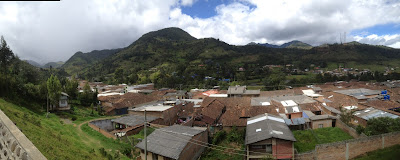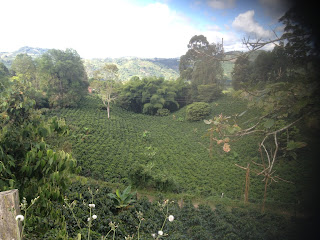 |
| The infamous Paseo de Prado |
OK, I am getting closer to catching up. Now it's time to talk about CUBA!
I went to Cuba for nine days with Natasha during the last portion of our "summer" break. I'm not even sure how to describe the trip other than to say we had an incredible time and Cuba is the most confusing country I have ever visited in terms of everyday life being affected by politics.
With the U.S. and Cuba opening up their borders to each other, we figured it would be a good time to go and see what the Europeans have been checking out for the last few decades before all the gringos change stuff. ;)
I guess I can't keep talking about Cuba, though, without describing the BIG, stupid, idiotic mistake we made and which we realized about ten minutes upon landing in Havana
... which was that we brought the wrong money to exchange.

Essentially, we read that we shouldn't bring U.S. dollars to exchange for Cuban pesos because Cuba charges a 10 percent tax on the exchange (just one of many of the effects of decades of poor relations between our countries).
"No problem," we said to each other. "We'll just bring our Colombian pesos!"
We got to the airport and found out that Colombian pesos can't be exchanged. Anywhere in Cuba.
Being the overly-confident travelers we were, we had neglected to check up on that.
So, we were stranded in Cuba with nothing but useless money. We had no U.S. dollars and credit cards that worked only in Colombia and the U.S. (thanks again to poor relations, most U.S. credit cards still don't work at Cuban atms).
Thankfully, our taxi driver worked with the hostel we stayed at and agreed to take us there for later payment. The hostel gave us bottled water to drink, and the next morning we set out to try and solve our money problem. We finally came upon an agency that helps tourists and desperately knocked on the door, even though it was Sunday and closed. A man opened up after we had been whining at the door for a while and kindly agreed to help us with our problem. Long story short, we got money wired from Natasha's mom, who had a calling card she used to call us at the hostel to get our information.
In the meantime, the man at the agency took pity on us and bought two of our meals. In our free time we walked around Havana in a weird state, knowing that everything truly was out of our reach with no money.
The fact that we were penniless for 24 hours in Cuba, though, made the rest of the trip all the sweeter.
 |
| First stop once we got money: Cuban manicures! |
 |
| View of the Malecon from the famous Hotel Nacional |
The next day, Natasha and I fondly refer to as Fun Day. We went a little crazy, running around old Havana, sipping on mojitos and coffees, getting our nails done, striking up conversation about what it's like to live in Cuba with street vendors, haggling over the price of jewelry, and jumping into one of Cuba's many infamous old-school cars, which served as a taxi, to drive along the equally infamous Malecon -- the seaside highway that carries you across the east and west sides of Havana.
 |
| Photos in our first old-time taxi ride along the Malecon |
 |
| More Malecon |
Havana is, in some ways, similar to Cartagena. They aren't too far from each other distance-wise and it's obvious that the same Spanish colonists inhabited the cities around the same time period, thanks to the colonial (and beautiful) architecture. Both have clearly made a concerted effort to maintain their historic downtowns (maybe even at the expense of directing resources to other parts of the city) but it was pretty obvious that there was far less upkeep in Havana overall.
It was bizarre to walk around Old Havana, with grandiose, beautiful colonial buildings, then turn one corner an feel as though we were in 1960s Brooklyn.
 |
| Malecon sunset |
I guess it was almost exactly as you would imagine it from pictures -- there were old men and women sitting outside on their stoops, many with a cigar hanging out of their mouths. There were vendors and pedi cabs and sooooo many children, riding bikes and playing baseball in the dirt streets between buildings. There was music everywhere. And, there really was this haze hanging among all of the tall, decaying buildings. I always noticed that gritty sort of coloring in pictures of Havana, and it's real! It's a real Havana Haze.
 |
| The view from one of our home stays with a dug up street |
Later on in our trip, we met a girl in Havana named Yodalis who spoke very good English. We took her out one night for dancing and pizza and picked her brain about Cuba.
We learned that Cubans make an average of about $25 per month, but living expenses are far higher than that. We saw a good deal of construction -- at times, the middle of the street would be completely dug up and residents would use boards laid over the giant ditches to get around -- and found out that construction is incredibly slow and omnipresent.
While we paid a fair price for our places to stay, we found out that our hosts probably barely see any of the money we pay them, because taxes are so high, and they must pay every month regardless of whether someone stays with them.
We learned that many Cubans seemed to contradict themselves in the same sentence regarding their opinion of Fidel Castro. Seen as a historic war hero who overthrew Batista, he was always spoken about in a respectful way at first. Cubans often mention how he brought first-class education and healthcare to the country, which is true to many extents. But in the same breath, they would finish by saying how horribly crummy the economy is in Cuba, and how difficult it is to make ends meet.
Yodalis said she would like to have a family, but can't imagine trying to raise children with so little money.
 |
| More dug up street |
We saw real-life propaganda, including a front-page newspaper article about the great Communist leader of China, and billboards everywhere about the greatness of Fidel. And Che Guevara's face ...absolutely everywhere!!
 |
| Cuba newspaper propoganda |
There was no internet except for one or two computers in established businesses and in a few zones in each city, where you had to pay for a card to use an hour of wifi.
Most Cubans seemed to like Raul Castro -- Fidel's brother, who has taken over since Fidel got sick. Raul is a lot more lax and one of the reasons that relations between the U.S. and Cuba have been improving. Before, Cubans weren't even allowed to leave the country to travel, and restaurants didn't exist as private businesses. Both of those things have changed, although Cubans receive rations of basic food staples and other necessities. For many average Cubans, cuisine outside of rice and meat and beans is simply too expensive to try.
It was weird to look at a big company -- the rum company, Havana Club, for example, or any classy hotel -- and realize that it was essentially a business arm of the government. I wanted to remain objective and apolitical while I was there, but I couldn't help but start to feel like it was just unfair to everyone who worked in any business that they didn't actually receive the money we were handing them.
Politics aside, though, Cuba was truly beautiful. After Havana, we took a two-hour taxi ride to Vinales, the region where most of that famous Cuban tobacco is made.
The farms, too, were completely retro -- everything done by hand.
In Vinales we went horseback riding to a cave, where we were guided through a pitch-black path to a pool of water. We jumped in and swam in the dark cave for a while ... and it was one of the more bizarre experiences of my life, haha.
 |
| Buddy shot after horseback riding in Vinales |
 |
| We swam in a cave! |
The next day we did some more cave exploring and saw a giant outdoor mural before heading to one of Cuba's notoriously pristine beaches.
 |
| Cayo Jutias beach |

The water was so warm, it was truly like stepping into bath water. And so, so clear. Cuban beaches were really living up to the expectation.
The last city Natasha and I visited was Trinidad, a colonial town farther east of Havana, full of cobblestone roads and live music on literally every corner at night.
We went on an awesome hike outside of town that lead us past a beautiful waterfall and then a pool of water where we went swimming, and we ended the trip with heading out to a bar that was in an actual cave. It was a little crazy for our taste, but it was pretty fun to be inside of an actual cave and drinking Bucanero (my favorite Cuban beer).
 |
| Pretty waterfalls! |
 |
| Where we ate lunch |
 |
| Rooftop view of Trinidad |
 |
| Trinidad sunset |
Natasha and I came home feeling as though, with no internet and literally no contact with anyone but each other and Cubans for the last nine days, we had truly gotten lost in the country. It was so incredibly interesting. I'd definitely go again ... wink wink, nudge nudge to anyone who is interested ;)



















































